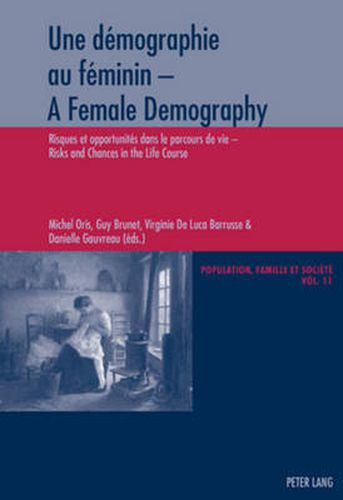Readings Newsletter
Become a Readings Member to make your shopping experience even easier.
Sign in or sign up for free!
You’re not far away from qualifying for FREE standard shipping within Australia
You’ve qualified for FREE standard shipping within Australia
The cart is loading…






Comme l'ensemble des sciences sociales, la demographie historique a eu au coeur de ses etudes un feminin pourtant invisible, car cache derriere le couple, la famille ou le statut social (masculin). A l'origine de cet ouvrage se situe l'affirmation qu'il est possible et indispensable de s'interesser aux itineraires feminins. Il ne faut bien sur pas les isoler artificiellement des parcours des hommes. C'est la demarche comparative et la prise en compte des interactions, de la construction des roles genres, qui permettent de s'interroger sur les specificites des trajectoires, sur ce qui est propre a l'un ou l'autre genre. Existe-t-il des comportements, des risques, mais aussi des opportunites specifiques pesant sur les parcours de vie feminins ? Les 13 contributions rassemblees dans ce livre repondent a cette interrogation en se centrant d'une part sur la mobilite, les migrations, d'autre part sur la maternite. Elles couvrent une periode allant du 17e au 20e siecle, en Europe et en Amerique du Nord, avec une large place accordee au Quebec.
Historical demography, like all the other social sciences, had women in the very core of its research agenda. Females were however hidden behind the couple, the family, or the (male) social status. This book claims that it is possible and necessary to investigate female trajectories. Of course, they cannot be artificially isolated from the male life courses. It is the comparative approach, the analysis of interactions of the construction of gender roles that highlight the specificities of biographies from a gender perspective. Do behaviors, risks but also opportunities exist that specifically affected women’s life courses? The 13 contributions of this book provide several answers. They are centered on two main issues, mobility and migration on the one hand, maternity on the other hand. A period from the 17th to the 20th century is covered, in Europe and North America, with a large focus on Quebec.
$9.00 standard shipping within Australia
FREE standard shipping within Australia for orders over $100.00
Express & International shipping calculated at checkout
Comme l'ensemble des sciences sociales, la demographie historique a eu au coeur de ses etudes un feminin pourtant invisible, car cache derriere le couple, la famille ou le statut social (masculin). A l'origine de cet ouvrage se situe l'affirmation qu'il est possible et indispensable de s'interesser aux itineraires feminins. Il ne faut bien sur pas les isoler artificiellement des parcours des hommes. C'est la demarche comparative et la prise en compte des interactions, de la construction des roles genres, qui permettent de s'interroger sur les specificites des trajectoires, sur ce qui est propre a l'un ou l'autre genre. Existe-t-il des comportements, des risques, mais aussi des opportunites specifiques pesant sur les parcours de vie feminins ? Les 13 contributions rassemblees dans ce livre repondent a cette interrogation en se centrant d'une part sur la mobilite, les migrations, d'autre part sur la maternite. Elles couvrent une periode allant du 17e au 20e siecle, en Europe et en Amerique du Nord, avec une large place accordee au Quebec.
Historical demography, like all the other social sciences, had women in the very core of its research agenda. Females were however hidden behind the couple, the family, or the (male) social status. This book claims that it is possible and necessary to investigate female trajectories. Of course, they cannot be artificially isolated from the male life courses. It is the comparative approach, the analysis of interactions of the construction of gender roles that highlight the specificities of biographies from a gender perspective. Do behaviors, risks but also opportunities exist that specifically affected women’s life courses? The 13 contributions of this book provide several answers. They are centered on two main issues, mobility and migration on the one hand, maternity on the other hand. A period from the 17th to the 20th century is covered, in Europe and North America, with a large focus on Quebec.